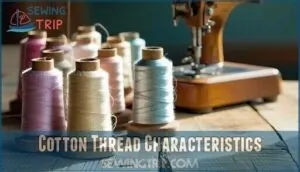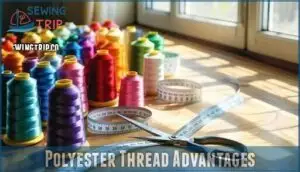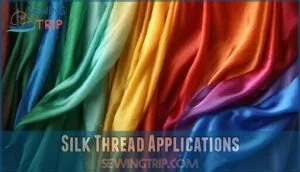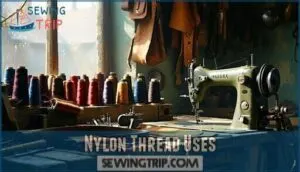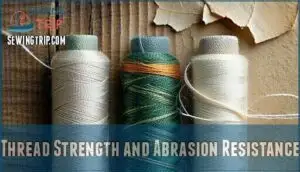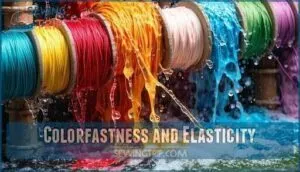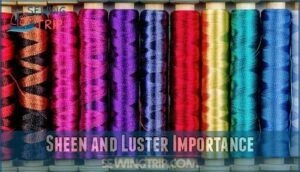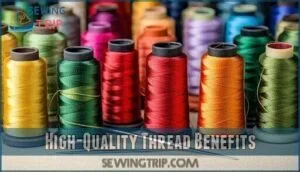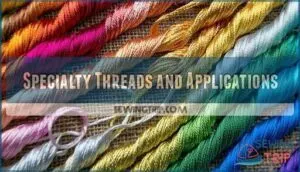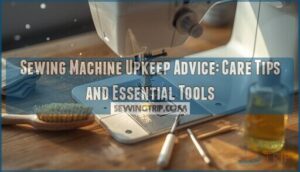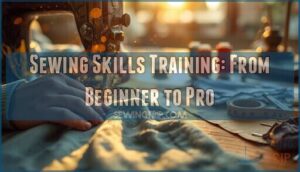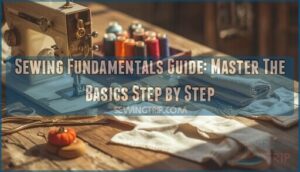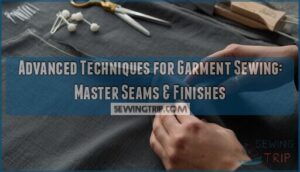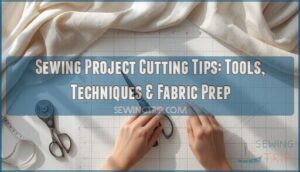This site is supported by our readers. We may earn a commission, at no cost to you, if you purchase through links.
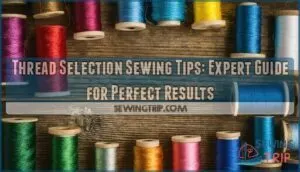 Mastering thread selection sewing tips starts with matching thread weight to your fabric—think of it as pairing wine with dinner.
Mastering thread selection sewing tips starts with matching thread weight to your fabric—think of it as pairing wine with dinner.
Use lightweight threads for delicate fabrics like silk, all-purpose for everyday cotton, and heavy-duty for denim or canvas.
Cotton offers natural breathability, polyester provides durability, and silk adds luxury.
Don’t overlook thread color; it can make or break your project’s appearance.
Quality matters more than quantity—cheap thread breaks easily and creates frustration.
Test your thread choice on fabric scraps first to avoid costly mistakes.
The right thread transforms good sewing into professional results that’ll make your grandmother proud, and it’s all about matching thread weight to your fabric, considering thread color, and using quality threads to ensure the best outcome.
Table Of Contents
Key Takeaways
- Match thread weight to your fabric type — you’ll get professional results when you pair lightweight threads with delicate fabrics like silk and heavy-duty threads with denim or canvas.
- Choose polyester for durability and cotton for natural compatibility — polyester threads resist breaking and maintain color better, while cotton threads work best with cotton fabrics and offer superior heat resistance.
- Test your thread selection on fabric scraps first — you’ll avoid costly mistakes and ensure proper tension, stitch quality, and color matching before starting your actual project.
- Invest in quality thread over cheap alternatives — superior threads reduce breakage, improve sewability, and create longer-lasting seams that won’t require frequent repairs or replacements.
Thread Selection Basics
Choosing the right thread transforms your sewing from frustrating to flawless, but most sewers grab whatever’s handy without considering the match.
Understanding thread basics—from weight compatibility to measurement systems—means you’ll spend less time troubleshooting and more time creating projects that actually hold up.
General Purpose Thread Uses
General purpose thread is your go-to choice for most sewing projects.
This versatile 100% polyester thread handles everything from delicate silk to heavy denim, making it perfect for seam construction across fabric types.
You’ll save money using one thread for multiple sewing projects, whether you’re hand sewing or machine sewing.
Its cost effectiveness and fabric versatility make proper thread selection simple for any sewing thread needs.
Thread Weight and Fabric Compatibility
Thread thickness must match fabric weight for superior results. Fine threads (60-100wt) suit delicate silk and chiffon, while medium fabrics like cotton need 40-50wt threads.
Heavy materials like denim require thick 12-30wt threads. Proper thread selection guarantees stitch quality, prevents fabric damage, and maintains machine tension.
Needle compatibility depends on thread weight—choose needles 40% larger than thread diameter for smooth sewing. For embroidery, understanding proper thread weight is essential for a professional finish.
Thread Measurement Systems
Understanding thread size measurement helps you match threads perfectly to your projects.
While fabric compatibility matters, knowing measurement systems prevents costly mistakes.
Denier vs Tex measures thread weight differently – denier calculates grams per 9,000 meters, while the tex system uses grams per 1,000 meters for more precise measurements.
- Metric Count System works backwards: higher numbers mean thinner threads, comparing length to weight ratios
- Cotton Count Explained through symbols like NeC, NeB, and Ne that indicate strand thickness measurements
- Fixed Weight Systems guarantee accurate measurement importance by providing consistent thread weight calculations across manufacturers
Choosing Right Thread Type
You’ll encounter four main thread types in your sewing projects, each with distinct advantages for different applications.
Understanding when to use cotton, polyester, silk, or nylon thread guarantees your finished projects look professional and withstand regular use.
Cotton Thread Characteristics
Natural cotton thread brings timeless appeal to your sewing projects with exceptional heat resistance and breathability.
You’ll appreciate how cotton thread perfectly complements cotton fabrics, creating seamless thread fiber compatibility. While cotton durability excels with natural fibers, it produces more lint than synthetic alternatives, requiring occasional machine cleaning for peak performance.
For those seeking quality materials, consider exploring options for buying cotton thread.
| Cotton Thread Properties | Benefits | Considerations |
|---|---|---|
| Heat Resistance | Withstands high ironing temperatures | Can shrink if pre-washed improperly |
| Natural Fiber Compatibility | Matches cotton fabric behavior | Less stretch than synthetic options |
| Lint Production | Biodegradable and eco-friendly | Requires more frequent machine maintenance |
| Thread Sewing Performance | Smooth finish on lightweight projects | May break under heavy-duty stress |
| Cotton Durability | Long-lasting with proper care | Fades faster than polyester threads |
Polyester Thread Advantages
Polyester thread stands as your go-to choice for most sewing projects, offering unmatched durability benefits that cotton simply can’t match.
This synthetic powerhouse delivers exceptional thread strength and superior color retention through countless washes. Polyester threads offer high abrasion resistance, making them ideal for projects requiring longevity.
- Durability Benefits: Polyester thread resists breaking and maintains integrity longer than natural fibers
- Color Retention: Colors stay vibrant wash after wash, unlike cotton that fades over time
- Versatility Applications: Works perfectly on all fabric weights, from delicate silk to heavy denim
- Cost Effectiveness: Affordable pricing with minimal lint production keeps your machine running smoothly
Silk Thread Applications
Several luxury projects benefit from silk thread’s exceptional qualities.
You’ll find its smooth finishes perfect for delicate fabrics like chiffon and lace, where synthetic alternatives might damage fibers.
Silk thread offers vibrant colors that complement natural materials beautifully.
While cost considerations make it pricier than polyester, its superior drape and luster justify the investment for heirloom garments and fine embroidery work.
Notably, silk has higher tensile strength than cotton or linen, making it a valuable choice for projects that require high quality and exceptional thread.
Nylon Thread Uses
Nylon thread stands as your go-to solution when silk’s delicacy won’t cut it.
This powerhouse handles heavy fabrics, leather projects, and outdoor applications with ease. Its superior thread strength and abrasion resistance make nylon thread indispensable for industrial sewing where thread durability matters most.
Smart thread selection means choosing nylon when your project demands unwavering performance under stress.
- Feel confident tackling leather upholstery knowing your stitches won’t fail
- Experience relief when outdoor gear seams stay intact through harsh conditions
- Gain satisfaction from durable repairs that outlast the original construction
- Enjoy peace of mind with thread types that match your toughest projects
Thread Properties and Performance
Understanding thread properties helps you choose materials that won’t let you down mid-project.
The right thread characteristics guarantee your finished pieces look professional and last through years of use and washing.
Thread Strength and Abrasion Resistance
Understanding thread durability factors starts with recognizing that material composition directly affects thread strength and abrasion resistance.
Synthetic threads outperform natural fibers in demanding applications, ensuring better stitch longevity and project lifespan through superior fraying prevention.
| Thread Type | Tensile Strength | Abrasion Resistance |
|---|---|---|
| Nylon | Highest | Excellent |
| Polyester | High | Very Good |
| Cotton | Moderate | Fair |
Thread properties like construction and twist count substantially impact thread durability. You’ll find that spun polyester threads offer exceptional thread abrasion resistance, making them ideal for upholstery and outdoor gear where thread selection matters most.
Colorfastness and Elasticity
Colorfastness testing reveals how well your thread color withstands washing and sunlight exposure.
Polyester threads excel here, maintaining vibrancy longer than cotton alternatives.
Thread elasticity determines seam performance under stress – fabrics with stretch need flexible threads to prevent breakage.
Different fiber types offer varying elasticity limits, affecting thread durability and overall project longevity.
Sheen and Luster Importance
Thread appearance plays a pivotal role in your project’s overall visual appeal.
Your thread selection directly impacts how decorative stitching catches light and enhances the finished piece.
- Thread sheen creates subtle light reflection that elevates professional-looking seams
- Thread luster adds depth and richness to embroidery and topstitching details
- Thread color with proper sheen complements fabric texture and pattern
- Decorative stitching benefits most from lustrous threads that highlight craftsmanship
For durable seams, consider matching thread fiber to the fabric.
High-Quality Thread Benefits
Quality thread selection transforms your sewing projects from amateur to professional.
The right thread makes all the difference between a project that lasts and one that falls apart.
You’ll notice reduced breakage immediately when you invest in superior thread – no more frustrating stops mid-seam.
Premium threads offer improved sewability, gliding smoothly through fabric without snagging.
While they cost more upfront, the long-term savings are substantial since you’ll avoid redoing seams or replacing damaged projects.
Your thread durability and thread strength directly impact your finished work’s professional appearance and longevity.
Specialty Threads and Applications
Beyond basic threads, you’ll discover specialty options that transform ordinary projects into extraordinary creations.
These specialized threads offer unique effects and solve specific sewing challenges that standard threads simply can’t handle.
Metallic Thread Uses
Metallic threads transform ordinary projects into glamorous showstoppers. You’ll find these specialty threads perfect for decorative stitching on evening wear, holiday crafts, and embellishment work.
However, metallic threads require careful tension adjustments and specialized needle selection to prevent breakage. Consider exploring options for purchasing metallic thread for your next project.
Use embroidery needles and reduce machine speed for best results in your thread sewing projects.
Glow-in-the-Dark Thread Effects
Beyond metallic shimmer, glow-in-the-dark threads offer luminous effects for your sewing thread projects.
These specialty threads absorb light during charging methods and emit visibility for several hours.
Thread composition typically includes phosphorescent materials mixed with standard fibers.
Perfect project ideas include children’s pajamas, costumes, or safety garments.
Consider safety concerns when selecting thread color options, ensuring adequate charging before use in glow-in-the-dark threads applications.
Wash-Away Thread Applications
Water-soluble washaway threads revolutionize temporary construction techniques.
You’ll find these dissolving threads perfect for embroidery stabilizing when working with delicate fabrics that can’t handle traditional removal methods.
They excel as basting alternatives for temporary seams in quilting applications, eliminating tedious unpicking.
These washaway alternatives save time on complex projects where thread temporary seams require precise placement before final stitching.
Using them also helps when you need specialty sewing threads for unique project needs, involving delicate fabrics and requiring precise placement.
Elastic Shirring Thread Uses
Mastering elastic shirring transforms your sewing projects with professional gathering effects.
This specialty thread combines latex and polyester for superior elasticity control, creating stunning waistbands, cuffs, and bodices.
Load elastic threads in your bobbin only, adjust tension settings higher, and space rows evenly.
Steam afterward to enhance gathering effects and achieve perfect shirring techniques.
Sewing Tips and Best Practices
You’ll master professional results when you match your thread choice to your specific project needs.
These practical tips guarantee your seams stay strong, your stitches look perfect, and your finished projects stand the test of time, ensuring perfect results.
Matching Thread to Fabric Type
Matching your fabric’s fiber content to the right thread types prevents costly mistakes.
Cotton fabrics work best with cotton thread, while synthetics pair with polyester options.
Consider thread shrinkage rates and garment intended use when making selections.
For color matching tips, choose thread one shade darker than your fabric.
Thread performance needs vary by project, so analyze thread selection factors carefully before cutting.
Selecting Needle Size and Thread Weight
Perfect needle-thread harmony prevents frustrating breakage and guarantees professional stitch quality.
Your sewing machine manual contains vital needle size recommendations that match specific thread weights and fabric types.
Here’s your essential Needle-Thread Ratio guide:
- Fine fabrics (silk, chiffon) – Size 60/8 needle with 50-60 weight thread
- Lightweight cottons – Size 70/10 needle with 40-50 weight thread
- Medium-weight fabrics – Size 80/12 needle with 30-40 weight thread
- Heavy denim, canvas – Size 100/16 needle with 20-30 weight thread
- Leather, upholstery – Size 110/18 needle with heavy-duty thread
Remember this golden rule: select needles 40% larger than your thread thickness.
This Fabric Thickness Guide prevents jamming while allowing smooth thread flow, eliminating those dreaded Tension Adjustments mid-project.
Adjusting Sewing Machine Tension
Thread tension troubleshooting starts with proper threading—90% of problems aren’t dial-related.
Check your upper tension first: increase settings when bobbin thread surfaces on top, decrease when needle thread appears underneath.
For bobbin tension, adjust removable cases only with quarter-turn screw movements.
Balanced stitching prevents fabric puckering and thread breaks.
Using Specialty Threads for Unique Effects
Specialty threads reveal creative possibilities that standard threads can’t match.
When experimenting with these materials, you’ll discover new ways to enhance your projects beyond basic construction seams.
Consider these specialty options for unique effects:
- Metallic threads add shimmer to embroidery and decorative stitching, though they require tension adjustments
- Wash-away threads create temporary seams that dissolve completely, perfect for basting complex pieces
- Heavy-duty threads with special coatings handle demanding applications like leather work and outdoor gear.
Thread experimentation with unique finishes transforms ordinary projects into standout pieces through strategic thread color matching and specialized sewing techniques.
Frequently Asked Questions (FAQs)
How do I choose the right thread for sewing?
Consider your fabric’s weight and fiber content first.
Match cotton thread to cotton fabric, polyester to synthetics.
Choose thread weight that complements fabric thickness—lighter threads for delicate fabrics, heavier for denim.
How to determine what thread to use?
Match your thread to your fabric’s weight and fiber content. Use lightweight thread for delicate fabrics like silk, heavier thread for denim. Consider polyester for durability, cotton for natural fabrics.
Which is thicker, 40 wt or 50 wt thread?
Don’t let thread weight numbers fool you—they’re backwards from what you’d expect. 40 weight thread is thicker than 50 weight thread. Lower numbers mean thicker threads, higher numbers mean thinner ones.
What tension should my sewing machine be on thread?
Start with normal tension (usually 3-5) and adjust gradually.
Thicker threads need lower tension, while finer threads require higher settings.
Test on fabric scraps first, then fine-tune until stitches look balanced.
How often should sewing thread be replaced?
Thread doesn’t expire like milk, but old spools lose strength over time. Replace thread every 3-5 years or when it becomes brittle, faded, or breaks frequently during sewing.
Can thread expire or go bad?
Thread doesn’t technically expire, but it can deteriorate over time.
Old thread becomes brittle, fades, and breaks easily during sewing.
Store it properly in cool, dry places to maintain quality and prevent premature aging.
What causes thread to break while sewing?
Poor thread quality, incorrect weight, wrong needle size, improper tension, or old thread causes breakage. You’ll also see breaks from sewing too fast, using damaged needles, or mismatched thread-to-fabric combinations.
How to store thread properly long-term?
Like a treasure chest preserving precious gems, you’ll want to shield your thread from light, moisture, and temperature swings.
Store spools upright in cool, dry spaces away from direct sunlight to prevent fading and deterioration.
Should thread match bobbin thread exactly?
You don’t need to match your bobbin thread exactly to your top thread, but it’s often recommended for best results.
Using the same thread prevents color show-through and guarantees consistent tension and stitch quality throughout your project.
Conclusion
Like Odysseus traversing treacherous waters, you’ve now charted the course through thread selection sewing tips that’ll elevate your craft.
You’ve learned to match thread weight with fabric type, understand material properties, and recognize when specialty threads shine.
Remember, quality trumps quantity every time—invest in good thread and your projects will thank you.
Test combinations on scraps before committing to final pieces, as these fundamentals transform ordinary sewing into professional-grade results that stand the test of time.
- https://sewingforaliving.com/sewing-threads-your-ultimate-guide-to-thread-types-applications-and-expert-tips/
- https://www.lovenotions.com/sewing-school-everything-you-need-to-know-about-thread
- https://makylacreates.com/types-of-sewing-threads/
- https://ieomsociety.org/proceedings/bangladesh2024/172.pdf
- https://www.superiorthreads.com/education/silk-thread-faq

